Cruising In Josef Stalin’s Packard
Want To Know What It’s Like To Be the Ruler of a Large, Powerful Nation? Then Climb Aboard and We’ll Go For a Ride In This ’36 Phaeton.
With a shiver of trepidation I slip behind the wheel of this grand 1936 Packard Phaeton Standard Eight parade car. That’s because its original owner would have had me shot for getting anywhere near it. You see, former Soviet Premier Joseph Stalin was not an easy-going guy…and he is reputed to have been the original owner of this regal machine.
This particular Packard was purchased by Stalin’s regime along with nine others and was exported to Russia by the United States government for Joe’s use. Years later, in 1990, it was shipped to Germany for restoration. And then three years after that it was shipped to John Scales in Dallas, an American restorer, for further work. His efforts took two years.
One thing led to another after that, and the car was put up for auction. It was then purchased by the Automobile Driving Museum along with a 1937 twelve-cylinder model. It has been part of the museum’s collection in El Segundo, California, along with several other Packards since that time. Now the car is used by the museum and appeared in the 2004 and the 2013 Pasadena Rose Parades.
Small In Front, Large In Back
The heavy door clicks shut as decisively as a cell door. The driver’s compartment is actually a bit cramped, perhaps because narrow front ends and fat fenders were the style of the day, but also it is cramped for legroom so as to emphasize the pedestrian position of the chauffer, and by contrast the grandeur of the rear seat passenger. That might not have been entirely to Stalin’s advantage, though, because he was actually a man of diminutive stature. He would have looked a bit like a pudgy child with a large mustache sitting in such a vast vehicle.
Indeed, the petite potentate was only about five feet five inches tall, and sensitive about it too. No doubt his chauffer was an even less imposing man so as not to upstage him. But for me at 6’1” and 210 pounds the seat is too close and the cockpit is too narrow.
Off to a Quiet, Yet Vigorous Start
I turn the key, press the starter button and the big 320-cubic-inch 130-horsepower inline flathead eight comes to life and settles into subservient silence.
The steering is heavy and takes real effort, and the turning radius is rather grand, so I do quite a bit of jockeying to head the car out onto the street from the museum’s parking lot.
Acceleration is dignified. One of Packard’s bigger Super Eight or V-12 engines would have made the car more lively, but then that extra oomph might have compromised its solemn dignity and detracted from the ominous specter of its passengers.
The long floor shift lever is truck-like, but the transmission is silky smooth. The brakes are vacuum-assisted mechanical, but are balanced and adequate for the car’s 5060-lb. weight. Once on the road the big Packard is easier to steer, though with yacht-like majestic handling due to its 139-inch wheelbase. But then you wouldn’t expect a car of such noble proportions to be nimble.
Perfect For a Parade
This big open Packard is a delight on this nice day though, with the wind wafting in my face. It more than lives up to its phaeton moniker. That was the term used to describe an open four-door touring car with no side windows as, opposed to a convertible sedan with windows that rolled up. Such cars were becoming less common by the 1930s, but were still ubiquitous in parades. There is plenty of film footage of Franklin D. Roosevelt waving from the back seat of a big Packard 12 phaeton, his cigarette holder held at a jaunty angle with Winston Churchill next to him.
Like rumble seats, phaetons are now a thing of the past. Most cars were open in the 1920s, but with the advent of safety glass and decent roads that were traversable in winter, closed cars became the norm. However, when political leaders wanted to project power in parades, such open cars were used by all the heads of state in the 1930s, and often as not they were Packards. Japanese Emperor Hirohito and the royal family had 10 of them. And other world leaders bought them as well. In fact, during the 1920s Packard exported more cars than any of the other luxury American carmakers.
Did He Really Use It?
Whether or not Stalin ever occupied this particular car is unknown, but it was not his usual means of transport from the Kremlin to his country estate. A fleet of closed Packard 15,000-pound limousines specially equipped with armor plating and three-inch-thick bulletproof glass handled that. And the reason for having more than one of those leviathans was that he changed cars often en route and used back roads to avoid potential assassins.
I wonder how many of Stalin’s top brass went for a ride in this car only to be taken for another ride to prison shortly thereafter. His comrades may have felt erroneously that they could breathe a little easier if they were invited to ride in the big guy’s car in a parade.
Packard 1; Bumps 0
But things have changed since the days when this Packard was reserved for Soviet leaders. These days even we, the average auto fanatics, can go for rides in Stalin’s parade car at the Automobile Driving Museum. The docents there will take you for a spin in it or any of several others of the museum’s classics on most Sundays all year round. More on that later, though.
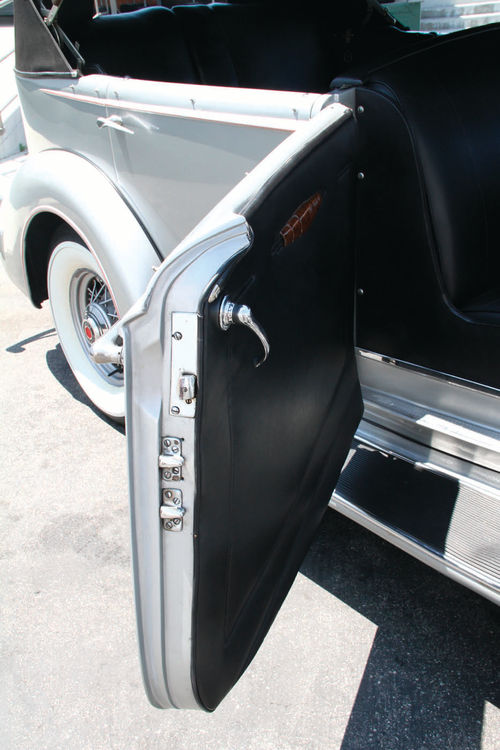

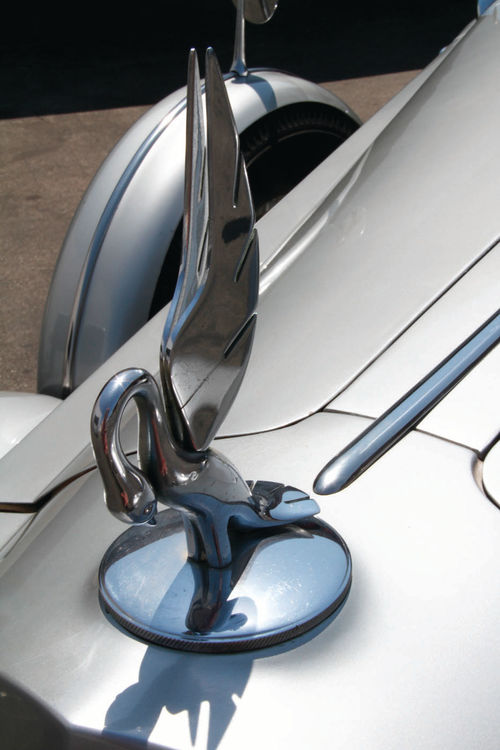
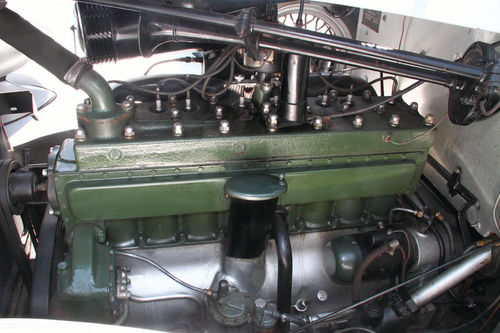
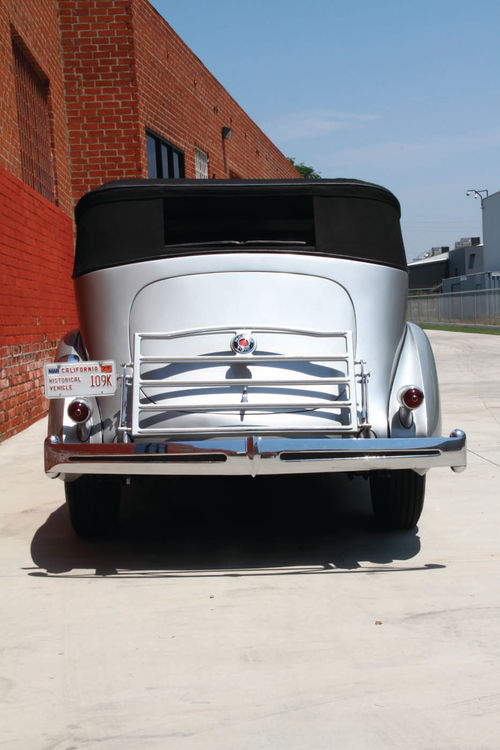

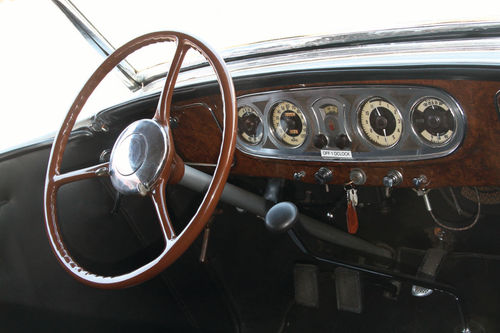
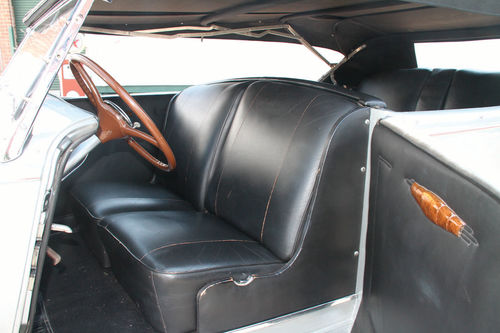
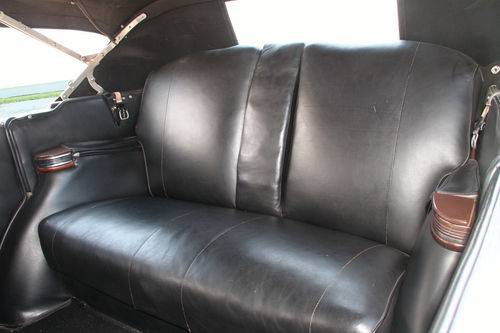
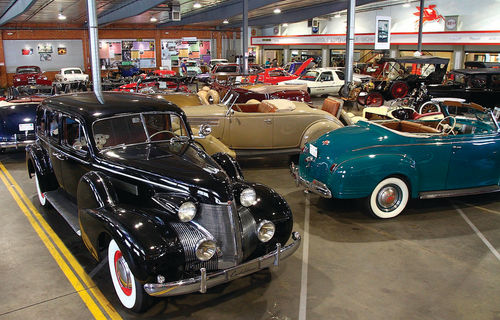
For now, we cruise imperiously, incurring stares, smiles and waves from the adoring peasantry along our route. Bumps are merely crushed out of existence because the car has a chassis like a truck, and the body is framed with white ash, with sheet metal stretched over it. Packard was one of the finest cars available in the 1930s, not because they necessarily employed cutting edge technology, but because the company’s senior cars were handbuilt, and their durability, craftsmanship and style were legendary.
Quick Pickup…Low Top Speed
Even though the car is heavy, it accelerates well from a standstill thanks to its 4.69:1 differential ratio, but the engine starts to work very hard at 50 miles per hour. I am doing a drive report for this magazine, but I am loath to try any fancy cornering or tossing the car around. After all, it wasn’t made for that. Instead it was designed to dawdle along while its passengers waved to an adoring crowd, and possibly for motoring (as opposed to driving) in the country.
Aimed At a Limited Audience
In the first few decades of the 20th century, Packard—along with Pierce and Peerless—were considered to be the finest American automobiles available. And to help maintain that image in the 1920s and ’30s, Packard sponsored only classical music on the radio along with other programs for those with refined tastes.
Some Packard Background
The company was founded in the 1890s shortly after the Packard brothers, James and William, bought a Winton automobile. It turned out to be unreliable and the brothers complained, at which point Alexander Winton stated: “If you’re so smart, why don’t you build a better machine yourself?” And they did.
The Packard brothers were already wellestablished in the electrical componentry business, and decided to try their hand at building cars too. Their first autos were simple 10-horsepower single-cylinder horseless carriages that were very well-engineered and sold well as a result.
The Packard Motor Co. came up with such innovations as the taillight and the steering wheel in 1900. The latter happened because the brothers were out for a spin in their latest offering one morning and hit a pothole. It caused the tiller to swing across and hit William on the knee, giving him a painful injury.
When the brothers got back to their shop they put their engineers onto the problem and the result was the modern steering wheel. The motoring media of the time panned it though, because they said it would not give the driver enough guidance as to which way he was headed, whereas the tiller pointed him in the right direction. The idea was only new in the U.S., though, because Panhard in France had been using modern steering wheels since 1894.
Making a Name For Itself
Then in 1903 E.T. “Tom” Fetch drove across the United States from San Francisco to New York in a Packard Model F he called “Old Pacific.” In many places out west there were no roads, so he drove alongside Pacific railroad tracks in order to be near a source of mail-order parts should he need them, hence the car’s nickname. It took 63 days to make the trip, and it was quite an arduous adventure back in the days when the pavement ended at the edge of town.
By 1913 Packard’s reputation as a maker of fine cars was well-established. It was at that time that they came up with the spiral bevel hypoid differential that was much quieter than the old straightcut type and also allowed the car to sit lower to the ground.
During World War I Packard made Liberty V-12 aircraft engines, and used that expertise to come out with their Twin Six after the war. It was the first production automotive V-12 and was legendary for its smoothness and power. It trumped Cadillac by four cylinders as well. Packard also offered large inline eights that were smooth and silent. Legend has it that you could balance a quarter on edge on the hood of a Packard of the era with the engine running.
Downsizing During the Depression
The car companies were hit hard by the stock market crash in 1929, and many didn’t survive. But due to their reputation and astute management Packard did well. They determined that the carriage trade was almost dead by the early ’30s, and that in order to survive the company would have to go to mid-priced cars built on an assembly line. So in 1935 they came out with their 120 line, which looked like a smaller Packard but had a smooth inline eight in it, and sold for much less than the senior models, as they called them.
The junior 120 models sold so well that in 1937 the company debuted an even less-expensive six-cylinder model called the 115 that sold even better than the 120 offerings. It was the right move at the right time and as a result 1937 was Packard’s best year ever. Ironically, the senior cars which were hand-crafted took as many workers as the mass-produced cars even though they soon became a small segment of the company’s production.
The junior 120 models sold so well that in 1937 the company debuted an even less-expensive six-cylinder model called the 115 that sold even better than the 120 offerings. It was the right move at the right time and as a result 1937 was Packard’s best year ever. Ironically, the senior cars which were hand-crafted took as many workers as the mass-produced cars even though they soon became a small segment of the company’s production.
In 1940 the company moved away from twelve-cylinder hand-built cars to a big 356-cubic-inch Super Eight as their top-of-the-line engine and opted for assembly line production entirely.
Sharing the Good Ride
Then in 1942 when America entered WWII, it is said that as a gesture of good will President Roosevelt gave tooling and dies for the senior Packards to the Russians, who made good use of them. The Soviet elite drove around in Packard knock-offs called ZiLs for another 20 years.
Whether the Russians reverseengineered the Packard or the Roosevelt story is true, communist leaders including China’s Mao Zedong and North Korea’s Kim Il-Sung continued to be conveyed in ZiLs. Production of the pre-war design had continued until 1958, after which the Soviets knocked off the mid-’50s Packards for their leaders.
Great Success…and Then The End
During World War II Packard redesigned for mass production and built more Rolls-Royce Merlin V-12 engines under license than Rolls did, in addition to manufacturing huge V-12 PT boat engines for the Navy. The Merlin engine was used in the P-51 Mustang fighter in the United States, along with the Lancaster bomber and other aircraft in Britain.
As a result, Packard emerged from the war debt-free, but new management made some unfortunate decisions such as buying Studebaker in 1953 and partnering up with Curtiss Aircraft—who thought the jet engine was just a passing fancy—and it did them in.
However, in all fairness, Packard was up against some fierce competition and did not have the flexibility and the economy of scale that the Big Three had, nor were they able to provide the flash and dash that the post-war customers demanded.
The last real Packard rolled off the assembly line at the Detroit factory in 1956, but some tarted-up Studebakers carried the badge until 1958. Sadly, the once-mighty Packard Motor Car Co., the former rival of Mercedes Benz, RollsRoyce and Cadillac, went out with a whimper rather than a bang.
But it was a great automaker while it lasted, and was able to produce 1,610,890 cars before closing its doors.
Back With Josef
We wheel around the neighborhood at the Driving Museum with our ’36 Packard taking pictures while I wear a sheepish grin, knowing that I am having my way with a car once owned by one of the most evil tyrants of the twentieth century; a century that had no shortage of evil tyrants. I will say one thing for Stalin though…he had good taste in automobiles.
Specifications
Body Style: 7-passenger touring sedan
Factory Price: $3270
Production: 5-10 this model, 3973 units all Standard 8s
Weight: 5060 lbs.
Engine: Straight 8 L-head
Horsepower: 130 @ 3200 rpm
Cubic Inches: 320
Wheel Base: 139 in.
Transmission: 3-speed floor shift
Brakes: 4-wheel mechanical with booster
Visit This Packard Yourself
If you find yourself in Southern California you might want to go for a ride in the Stalin Packard too. On most Sundays the Automobile Driving Museum pulls three cars from their magnificent collection to take people for rides. The vehicle could be anything from a 1957 Ford retractable to a 1930 Model A to Joseph Stalin’s very own Packard Touring car, and you can also view their extensive and well-curated collection of classics as well.
You don’t need to worry about the kids, either. There is a place for the toddlers to play, and the older ones are welcome to touch and even climb into many of the classics on display.
The cars are arranged according to era, starting with an 1885 Daimler Benz and going up through the brass and nickel eras, the Depression and the war years, and into the ’50s, ’60s and ’70s.
If you happen to be at Los Angeles International Airport on a layover, the museum is just blocks away, well worth seeing, and they have a snack bar too. But be careful, if you are a car buff you could easily lose track of time and miss your connecting flight.
But whether you’re a visitor or a local and you want to more than merely view classic cars, I recommend the museum highly. You too can sit in one of the first Pontiacs from the ’20s, Stalin’s 1936 Packard Touring car or even a 1958 Edsel.
Their contact information is: 610 Lairport St. El Segundo, CA 90245 automobiledrivingmuseum.org
















